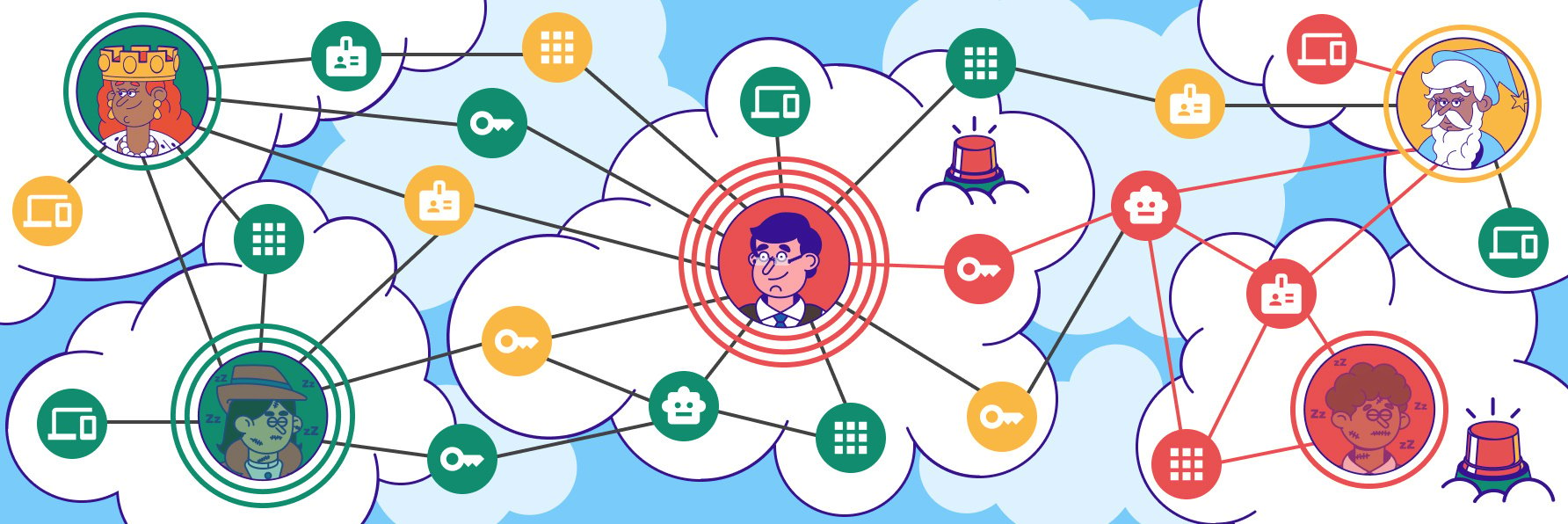Identity Threat Detection and Response (ITDR)

Table of Contents
- Introduction to Identity Threat Detection and Response (ITDR)
- Understanding Identity-Based Threats
- The Fundamentals of ITDR
- Core Technologies and Approaches in ITDR
- Implementing an Effective ITDR Strategy
- ITDR Across Different Environments
- Human and Non-Human Identity Protection in ITDR
- ITDR in Action: Threat Detection and Response
- Measuring ITDR Effectiveness
- Future Trends in Identity Security
- Conclusion: The Imperative of Comprehensive Identity Security
Hear Ye, Hear Ye
Subscribe to Cloud Chronicles for the latest in cloud security!
Introduction to Identity Threat Detection and Response (ITDR)
In today's digital landscape, a single compromised identity can lead to a multi-million-dollar breach. Traditional identity management is no longer sufficient to protect against sophisticated cyber threats. Enter Identity Threat Detection and Response (ITDR) – a proactive approach that safeguards your organization's most critical asset: its digital identities.
80% of cyberattacks use identity-based attack methods [1].
ITDR combines continuous monitoring, advanced analytics, and automated response mechanisms to detect and mitigate identity-related risks in real-time. By focusing on the behaviors and activities associated with identities, it helps organizations identify and respond to potential compromises before they can cause significant damage.
This guide explores ITDR's core components, implementation strategies, and best practices. We cover:
- Key technologies powering ITDR
- Implementing ITDR across different IT environments
- Protecting both human and non-human identities
- Measuring ITDR effectiveness
- Future trends in identity security
Whether you're new to ITDR or looking to enhance your existing strategy, this resource provides practical insights to strengthen your organization's identity security posture.
Understanding Identity-Based Threats
Types of Identity-Based Attacks
Identity-based threats have evolved significantly, exploiting the complexities of modern digital environments. These threats can be categorized into several key types:
- Credential Stuffing: Attackers use stolen username/password pairs to gain unauthorized access to user accounts. They often obtain these credentials from data breaches and try them across multiple services.
- Phishing: Attackers trick users into revealing their login credentials through fake websites or emails that mimic legitimate services. Spear phishing targets specific individuals or organizations for more focused attacks.
Phishing (16%) and compromised credentials (15%) are the two most common initial attack vectors for data breaches [2]. - Password Spraying: Instead of trying many passwords for one account, attackers use a few common passwords against many accounts. This helps them avoid account lockouts while attempting to breach multiple targets.
- Account Takeover (ATO): Once attackers gain access to an account, they may change settings, steal data, or use the account for further malicious activities. ATO can lead to significant financial and reputational damage.
- Privilege Escalation: Attackers who gain initial access to a low-level account attempt to increase their privileges, often exploiting system vulnerabilities or misconfigurations.
Breaches caused by compromised credentials or insider threats take the longest to resolve, with a mean time to identify and resolve of 328 days and 308 days [3].
Common Attack Vectors
Cybercriminals exploit various weaknesses to launch identity-based attacks:
- Weak or Reused Passwords: Many users still rely on easily guessable passwords or reuse passwords across multiple accounts, making them vulnerable to attacks.
- Insecure APIs: Poorly secured Application Programming Interfaces can provide attackers with opportunities to manipulate or steal identity data.
- Social Engineering: Attackers exploit human psychology to trick individuals into revealing sensitive information or granting access to secure systems.
- Unpatched Vulnerabilities: Outdated software or systems with known security flaws offer easy entry points for attackers targeting identity information.
Emerging Threats in the Identity Space
The landscape of identity-based threats continues to evolve:
- AI-Powered Attacks: Cybercriminals increasingly use artificial intelligence to create more sophisticated phishing attempts and to automate attacks at scale.
- Synthetic Identities: Attackers combine real and fake information to create new identities, which they use for fraud or to bypass security measures.
- Multi-Factor Authentication (MFA) Bypass: As MFA becomes more common, attackers develop new methods to circumvent these additional security layers, such as real-time phishing techniques.
- Cloud Identity Threats: The shift to cloud-based services introduces new risks, including misconfigured identity and access management settings in cloud environments.
- IoT Identity Exploitation: The growing Internet of Things (IoT) ecosystem presents new challenges in managing device identities and securing the data they access.
Understanding these threats helps organizations develop more effective ITDR strategies to protect their digital identities and sensitive information.
The Fundamentals of ITDR
Key Components
ITDR is built on five core components that work together to provide comprehensive identity protection:
- Continuous monitoring: Tracks identity activities across all environments, including on-site, cloud, and hybrid systems.
- Behavioral analysis: Uses advanced analytics to establish normal user behaviors and spot unusual activities that may signal security risks.
- Risk assessment: Scores potential threats in real-time based on their likelihood and impact.
- Automated response: Takes immediate action when it detects threats, such as firing alerts, requiring additional authentication or revoking access.
- Forensics and reporting: Enables thorough post-incident analysis and helps meet compliance requirements.
ITDR vs. Traditional IAM
ITDR improves upon traditional Identity and Access Management (IAM) in several ways:
- ITDR adds ongoing threat detection and response to IAM's access management and policy enforcement.
- While IAM typically uses static rules, ITDR adapts security measures in real-time.
- ITDR analyzes behavior patterns to make more nuanced security decisions than IAM's rule-based approach.
- ITDR actively works to prevent threats, whereas traditional IAM mainly reacts to issues after they occur.
- ITDR provides visibility in the actions an identity undertakes after authentication.
Role in Comprehensive Cybersecurity
ITDR plays a crucial role in overall cybersecurity:
- It enhances other security measures like firewalls and endpoint protection by focusing on identity-based threats across multiple environments.
- ITDR supports the Zero Trust model by being able to detect if an identity has gone rogue.
- By providing real-time insights into user behaviors, ITDR helps organizations create more effective security policies thereby hardening the identity security posture of the organization.
- ITDR connects identity management with threat detection, creating a more complete security strategy.
As organizations face increasingly complex digital environments, ITDR becomes essential to cybersecurity strategies. It offers a flexible, responsive approach to identity security that adapts to today's changing threat landscape.
Core Technologies and Approaches in ITDR
ITDR leverages several advanced technologies to provide comprehensive identity protection. Understanding these core components is crucial for effective implementation.
User and Entity Behavior Analytics (UEBA)
UEBA is the cornerstone of modern ITDR systems, using machine learning to establish and monitor behavioral baselines.
Key features:
- Continuous learning: UEBA systems adapt to changing user behaviors over time.
- Anomaly detection: Identifies deviations from normal patterns that may indicate threats.
- Risk scoring: Assigns risk levels to users and entities based on their behavior.
Example: A UEBA system might flag an account accessing sensitive data outside of normal working hours or from an unusual location.
Privileged Access Management (PAM)
PAM extends traditional access control by providing granular oversight of high-risk accounts.
Key components:
- Just-in-Time (JIT) provisioning: Grants elevated privileges only when needed and for a limited time.
- Session monitoring: Records and analyzes activities during privileged sessions.
- Automated de-provisioning: Quickly revokes access when no longer needed or when suspicious activity is detected.
Example: A system administrator requires elevated access to perform maintenance. PAM grants this access for a specified timeframe and monitors all actions taken during the session.
Identity Analytics and Risk Scoring
This technology processes vast amounts of identity-related data to provide real-time risk assessments.
Key aspects:
- Multi-factor analysis: Considers factors like access patterns, device information, and contextual data.
- Dynamic risk calculation: Continuously updates risk scores based on current behavior and environmental factors.
- Policy enforcement: Triggers adaptive authentication or access restrictions based on risk scores.
Example: An employee's risk score might increase if they suddenly access multiple sensitive systems from a new device, prompting additional authentication steps.
Automated Response and Remediation
Automated responses enable swift action against potential threats, reducing the window of vulnerability.
Key capabilities:
- Predefined playbooks: Automated response sequences for common threat scenarios.
- Adaptive authentication: Increases security requirements based on risk levels.
- Account lockdown: Automatically restricts or suspends high-risk accounts.
Example: If multiple failed login attempts are detected from an unusual location, the system might automatically require multi-factor authentication or temporarily lock the account.
Integration with Existing Security Infrastructure
ITDR solutions must work in concert with other security tools to provide comprehensive protection.
Integration points:
- SIEM systems: Correlates identity data with broader security events.
- EDR tools: Combines identity insights with endpoint behavior for more accurate threat detection.
- IGA platforms: Ensures that identity governance policies are enforced and monitored in real-time.
Example: An ITDR system detects suspicious identity activity and correlates this with network traffic data from the SIEM, providing a more complete picture of a potential attack.
By leveraging these core technologies in an integrated approach, ITDR provides a robust, adaptive framework for protecting digital identities against evolving threats.
Implementing an Effective ITDR Strategy
Implementing a robust ITDR strategy is crucial for organizations aiming to protect their digital assets in today's complex threat landscape. This section outlines key steps to develop and execute an effective ITDR approach.
Assessing Current Identity Security Posture
Before implementing ITDR, organizations must thoroughly evaluate their existing identity security measures. This assessment involves:
- Identifying all identity types within the organization, including human and non-human identities
- Evaluating current access control policies and their effectiveness
- Analyzing existing identity-related incident detection and response capabilities
- Identifying gaps in identity governance and administration
This assessment provides a clear picture of the organization's strengths and vulnerabilities, forming the foundation for a targeted ITDR strategy.
Developing an ITDR Roadmap
An ITDR roadmap outlines the path from the current state to the desired security posture. Key elements include:
- Define clear, measurable objectives for the ITDR program
- Prioritize high-risk areas and critical assets for protection
- Outline a phased implementation approach, balancing quick wins with long-term goals
- Allocate necessary resources, including budget, personnel, and technologies
- Establish timelines and milestones for implementation and evaluation
Best Practices for ITDR implementation
Successful ITDR implementation relies on adhering to industry best practices:
- Ensure cross-functional collaboration between security, IT, and business units
- Continuously refine behavioral baselines and risk models
- Integrate ITDR with existing security infrastructure and incident response plans
- Provide comprehensive training to security teams and end-users
- Regularly test and update ITDR processes to address evolving threats
80% of say that better identity management solutions/practices would have prevented some or all of the attacks on their organization [5].
By following these steps and best practices, organizations can develop a comprehensive ITDR strategy that enhances their overall security posture and protects against identity-based threats.
ITDR Across Different Environments
As organizations adopt diverse IT infrastructures, ITDR strategies must adapt to protect identities across various environments.
On-premises ITDR Considerations
In on-premises environments, ITDR focuses on:
- Integrating with existing identity and access management (IAM) systems to leverage current investments and ensure comprehensive coverage.
- Enhancing monitoring of privileged accounts and critical systems to detect potential insider threats or account compromises.
- Implementing behavior analytics to establish baselines for normal user activities and flag anomalies.
- Addressing data residency and compliance requirements specific to on-premises data storage and processing.
Multi-Cloud and Multi-Environment ITDR Strategies
As organizations migrate to the cloud, ITDR strategies must evolve to address:
- Implement consistent identity security policies across multiple cloud platforms and services for example, from the IdP ->IaaS -> PaaS-> SaaS layers.
- Utilize cloud-native security tools and APIs to enhance visibility and control over identity-related activities.
- Address the challenges of managing ephemeral identities in containerized and serverless environments.
- Monitor for cloud-specific identity threats, such as overprivileged roles or misconfigured identity providers.
Multi-cloud environments add complexity, requiring ITDR solutions that can provide a unified view of identities and threats across diverse cloud platforms.
ITDR in Hybrid Environments
For organizations with hybrid infrastructures, ITDR strategies must:
- Maintain consistent identity security policies and monitoring across on-premises and cloud resources.
- Implement federated identity solutions to ensure seamless and secure authentication across diverse environments.
- Develop unified monitoring and analytics capabilities to provide a holistic view of identity risks and threats.
- Address potential security gaps in the transition between on-premises and cloud environments.
Cross-environment ITDR Best Practices
Regardless of the environment, effective ITDR should:
- Implement continuous monitoring and real-time alerting for identity-related anomalies.
- Utilize machine learning and AI to improve threat detection accuracy and reduce false positives.
- Integrate ITDR solutions with broader security information and event management (SIEM) systems for comprehensive threat analysis.
- Regularly update and test ITDR processes to address evolving identity-based threats across all environments.
By tailoring ITDR strategies to each environment's unique characteristics while maintaining a consistent security posture, organizations can effectively protect against identity-based threats across their entire IT infrastructure.
Human and Non-Human Identity Protection in ITDR
Effective ITDR strategies must address both human and non-human identities to create a comprehensive security posture. This section explores key considerations and best practices for protecting diverse identity types within an ITDR framework.
The total number of identities in an organization (humans and machines) is expected to grow by 240% over the next 12 months [4].
Securing User Accounts and Access – Protecting Human Identities
ITDR for human users focuses on:
- Implementing risk-based authentication that adapts to user behavior, location, and device characteristics.
- Utilizing User and Entity Behavior Analytics (UEBA) to detect anomalies in user activities that may indicate compromised accounts.
- Integrating Identity Governance and Administration (IGA) with ITDR to ensure appropriate access rights and swift deprovisioning.
- Conducting regular privilege audits and implementing least privilege access principles.
Managing Service Accounts and API Identities – Protecting Non-Human Identities
ITDR strategies for non-human identities, including service accounts, API keys, and OAuth tokens, involve:
- Implementing robust lifecycle management for machine identities, including automated provisioning and decommissioning.
- Utilizing Privileged Access Management (PAM) solutions to secure and monitor high-risk service accounts.
- Employing API gateways with advanced analytics to detect and respond to abnormal API usage patterns.
- Developing specific ITDR protocols for the onboarding of new PaaS and SaaS services.
Balancing Security and User Experience - Unified ITDR Approach
To effectively protect all identity types:
- Implement a centralized ITDR platform that provides visibility and control across both human and non-human identities, and across all environments.
- Develop correlation rules that can identify complex attack patterns involving multiple identity types.
- Establish consistent security policies and response procedures applicable to all identity categories.
- Regularly update and test ITDR processes to address evolving threats across the entire identity ecosystem.
By addressing the unique challenges of both human and non-human identities within a unified ITDR framework, organizations can significantly enhance their overall security posture and resilience against identity-based threats.
ITDR in Action: Threat Detection and Response
Effective ITDR relies on a well-orchestrated process of detection, investigation, response, and continuous improvement.
Identifying Suspicious Activities and Anomalies
Identifying suspicious activities and anomalies is the first step in ITDR. Advanced ITDR systems use machine learning algorithms to establish baselines of normal behavior. This enables the detection of deviations such as unusual login patterns, sudden changes in access requests, or unexpected privileged account usage. By understanding typical user behavior, these systems can quickly flag potential threats for further investigation.
Investigating Potential Identity Threats
When anomalies are detected, a thorough investigation process begins. This involves correlating data from various sources, including system logs, network traffic, and endpoint data. Automated triage systems help prioritize high-risk alerts, ensuring critical threats receive immediate attention. Analysts use this holistic view to determine the scope and potential impact of each threat.
Automated and Manual Response Processes
Response processes in ITDR must balance speed with accuracy. Many organizations implement a tiered strategy:
- Automated responses handle common, low-risk threats (e.g., temporarily locking accounts after multiple failed logins)
- More complex scenarios are escalated for manual intervention.
- Orchestration tools streamline workflows for both automated and manual responses.
Post-incident Analysis and Continuous Improvement
After each incident, security teams conduct thorough reviews to identify gaps in detection or response procedures. These insights drive updates to threat detection rules, response playbooks, and overall ITDR strategies. Regular tabletop exercises further refine these processes, ensuring the organization remains prepared for evolving identity-based threats.
Measuring ITDR Effectiveness
Assessing ITDR effectiveness requires a comprehensive approach that combines quantitative metrics with qualitative analysis.
Key Performance Indicators (KPIs) for ITDR
Essential KPIs for measuring ITDR performance include:
- Mean Time to Detect (MTTD): Average time to identify potential identity threats
- Mean Time to Respond (MTTR): Average time from detection to containment
- False Positive Rate: Percentage of incorrectly identified threats
- Identity Coverage: Percentage of identities protected by ITDR measures
- Threat Resolution Rate: Percentage of identity-related incidents successfully resolved
Regularly tracking these KPIs provides insights into the overall effectiveness of the ITDR program and highlights areas for improvement.
Metrics for Assessing Identity Risk and Security Posture
To evaluate the organization's identity security posture, consider:
- Identity Risk Score: Aggregate various risk factors to assess overall security stance
- Privileged Access Usage: Monitor frequency and duration of elevated access rights utilization
- Policy Violation Rate: Track instances of non-compliance with identity policies
- Authentication Failure Rate: Measure unsuccessful login attempts and potential brute-force attacks
- Dormant Account Ratio: Identify and manage inactive user accounts
Employ comprehensive metrics to evaluate overall identity security. Use these metrics to indentify weak points and prioritize improvements.
- Implement real-time dashboards for continuous monitoring of key metrics.
- Conduct regular security posture assessments to identify evolving vulnerabilities.
- Perform periodic penetration testing focused on identity-based attack vectors.
- Establish a feedback loop between incident response teams and ITDR processes.
- Benchmark against industry standards and peer organizations.
- Invest in ongoing training for security teams to keep pace with evolving threats.
By consistently measuring, monitioring, and improving ITDR programs, organizations can enhance their protection against identity-based threats and demonstrate value to stakeholders.
Future Trends in Identity Security
As the digital landscape evolves, so too must the strategies for protecting digital identities. Several key trends are shaping the future of ITDR:
Artificial Intelligence and Machine Learning in ITDR
AI and ML are revolutionizing ITDR by:
- Enhancing threat detection accuracy through advanced pattern recognition
- Automating response processes for faster threat mitigation
- Providing predictive insights to anticipate potential attacks
- Continuously adapting to new attack patterns in real-time
These technologies enable ITDR systems to detect subtle anomalies in user behavior that might escape human analysts, significantly improving overall security posture.
Zero Trust and ITDR
The integration of Zero Trust principles with ITDR is leading to:
- More granular access controls based on continuous risk assessment
- Real-time authentication and authorization for every identity interaction
- Enhanced visibility into user activities across the entire network
This convergence strengthens security by eliminating implicit trust and continuously verifying every access request.
Predictive Identity Threat Intelligence
Emerging predictive technologies are shifting ITDR from reactive to proactive by:
- Analyzing vast amounts of data to forecast potential identity-based attacks
- Enabling preemptive security measures based on predicted threat patterns
- Continuously refining threat models using machine learning algorithms
This proactive approach promises to significantly enhance an organization's ability to prevent identity-based attacks before they occur.
Conclusion: The Imperative of Comprehensive Identity Security
Identity Threat Detection and Response (ITDR) has become a cornerstone of modern cybersecurity strategies. As we've explored, effective ITDR encompasses a wide range of practices, from proactive measures to reactive capabilities, all aimed at safeguarding digital identities.
Key principles of a robust ITDR strategy include:
- Comprehensive protection for both human and non-human identities
- Continuous monitoring and adaptive security measures
- Balancing stringent security with positive user experience
- Seamless integration with broader cybersecurity frameworks
As cyber threats continue to evolve in sophistication and scale, the importance of ITDR in protecting organizational assets cannot be overstated. It's imperative for businesses to stay ahead of emerging trends and technologies in identity security.
We strongly encourage organizations to:
- Assess their current identity security posture
- Identify gaps in their ITDR capabilities
- Implement a comprehensive ITDR strategy tailored to their specific needs
- Select an ITDR solution that has real time threat detection and response capabilities
- Select an ITDR solution that unifies identity security for human and non-human identities, across all environments i.e IdP->IaaS->PaaS->SaaS
By taking these proactive steps, organizations can better protect their critical assets, maintain operational integrity, and build trust with stakeholders in an increasingly digital world. In the face of ever-evolving cyber threats, a robust ITDR strategy is not just a security measure—it's a business imperative.
Source:
[1] CrowdStrike 2024 Global Threat Report
[2], [3] IBM Cost of a Data Breach Report 2024
[4] 2024 Identity Security Threat Landscape Report
[5] One Identity 2022 Identities and Security Survey Results










